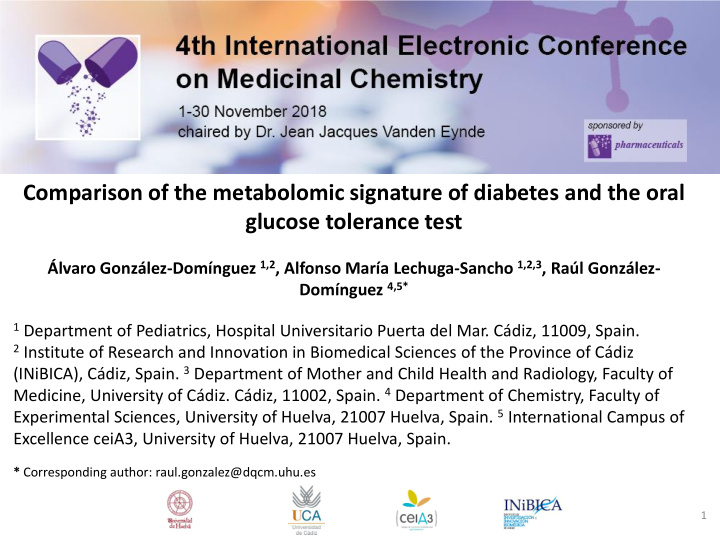



Comparison of the metabolomic signature of diabetes and the oral glucose tolerance test Álvaro González-Domínguez 1,2 , Alfonso María Lechuga-Sancho 1,2,3 , Raúl González- Domínguez 4,5* 1 Department of Pediatrics, Hospital Universitario Puerta del Mar. Cádiz, 11009, Spain. 2 Institute of Research and Innovation in Biomedical Sciences of the Province of Cádiz (INiBICA), Cádiz, Spain. 3 Department of Mother and Child Health and Radiology, Faculty of Medicine, University of Cádiz. Cádiz, 11002, Spain. 4 Department of Chemistry, Faculty of Experimental Sciences, University of Huelva, 21007 Huelva, Spain. 5 International Campus of Excellence ceiA3, University of Huelva, 21007 Huelva, Spain. * Corresponding author: raul.gonzalez@dqcm.uhu.es 1
Comparison of the metabolomic signature of diabetes and the oral glucose tolerance test 2
Abstract: Intervention trials attempt to clarify the possible effects of certain challenge tests on study subjects (e.g. drugs effectiveness, environmental exposure experiments), while observational studies employ free-living populations to analyze the relationship between a particular effect and possible triggering factors. Based on the hypothesis under investigation, the researcher will choose the appropriate study design. Nevertheless, here we report the utility of combining observational and interventional studies to discover confident biomarkers in the clinical field. We contrasted metabolomic profiles related with diabetes and the oral glucose tolerance test (OGTT), a clinical test used to simulate the hyperinsulinemia observed in diabetes. We found that the main metabolic changes occur in the same metabolite classes, including energy-related metabolites, amino acids (especially brain chain amino acids, BCAA) and multiple lipids, such as free fatty acids, acyl-carnitines, triglycerides and phospholipids, among them. Hence, challenge tests such as the OGTT guarantee to be a great strategy to investigate pathological signatures associated with the development of diseases as a previous step before performing validation works in observational studies. Keywords: metabolomics; diabetes; oral glucose tolerance test 3
Introduction Observational study design Intervention study design The study population is not under Direct assessment of the effect of a control, the investigator simply particular intervention on the ‘observes’ and evaluates the investigated outcome relationship between a given outcome and possible triggering or associated factors the controlled environment allows sharpening metabolic alterations, thus simplifying the experimental large sample sizes are needed to design minimize inter-subject variability the combination of complementary observational and interventional studies stands out as a very reliable strategy to discover confident metabolomic biomarkers 4
Introduction Oral Glucose Tolerance Test (OGTT) Diabetes Method to diagnose IR Disorder characterized by based on determining how high blood sugar and quickly an oral glucose insulin resistance (IR) overload is cleared from the blood common metabolic signatures the OGTT can be used to elucidate pathological hallmarks of diabetes and related metabolic disorders, as well as to better understand how different people respond in different ways to the same stimulus, setting the basis for a more personalized medicine 5
Results and discussion: Metabolomics in diabetes Alterations in energy metabolism glucose up-regulated glycolysis alanine pyruvate lactate ketone acetyl-CoA acetyl-carnitines bodies increased rates of β -oxidation fatty acids increased ketogenesis citrate malate TCA TCA depletion fumarate succinate Int. J. Obes. , 2016 , 40 , 1494-1502 2-ketoglutarate Physiol. Genomics , 2007 , 29 , 99-108 J. Physiol. Biochem. , 2014 , 70 , 117-128 6
Results and discussion: Metabolomics in diabetes Homeostasis of amino acids hyperinsulinemia over-activated proteolysis and gluconeogenesis amino acids (branched chain amino acids) precursor organic acids (3-methyl-2-oxovalerate, 2-hydroxybutyrate, 2-aminoadipate) protein catabolism metabolites (creatine, creatinine) Chromatographia , 2009 , 69 , 941-948 Diabetes , 2013 , 62 , 4270-4276 Clin. Chim. Acta , 2018 , 477 , 39-47 7
Results and discussion: Metabolomics in diabetes Lipidomic perturbations Accumulation of total lipids Metabolism of membrane lipids triglycerides free fatty acids acyl-carnitines Diabetologia , 2016 , 59 , 2349-2359 J. Proteome Res. , 2009 , 8 , 1623-1630 J. Physiol. Biochem. , 2014 , 70 , 117-128 J. Exp. Med. , 2008 , 205 , 2975-2984 Talanta , 2011 , 85 , 1711-1720 8
Results and discussion: Metabolomics in OGTT Alterations in energy metabolism acute intake of carbohydrates causes a transitory hyperinsulinemic state, which promotes glucose uptake and switches the organism from catabolism to anabolism glucose metabolism β -oxidation lipolysis ketogenesis proteolysis gluconeogenesis Mol. Syst. Biol. , 2008 , 4 , 1-9 Electrophoresis , 2017 , 38, 2313-2322 AJP Endocrinol. Metab. , 2008 , 296 , E384-E393 Metabolomics , 2010 , 6 , 56-66 9
Results and discussion: Metabolomics in OGTT Lipidomic perturbations lyso-phospholipids phospholipids ceramides sphingomyelins triglycerides diglycerides monoglycerides bile acids Electrophoresis , 2017 , 38, 2313-2322 AJP Endocrinol. Metab. , 2008 , 296 , E384-E393 Diabetes , 2013 , 62 , 2689-2698 Mol. Syst. Biol. , 2008 , 4 , 1-9 10
Conclusions Metabolomics has demonstrated that similar metabolic disturbances occur in patients affected by diabetes and subjects undergoing an oral glucose tolerance test (OGTT) The most important metabolic alterations have been found in circulating levels of carbohydrates and related energy-metabolites, amino acids and lipids, thus evidencing profound impairments in energy metabolism and dyslipidemia Challenge tests provide a great opportunity to investigate pathological hallmarks associated with the development of diseases in a feasible manner s a starting point before to be validated in larger observational studies. 11
Recommend
More recommend